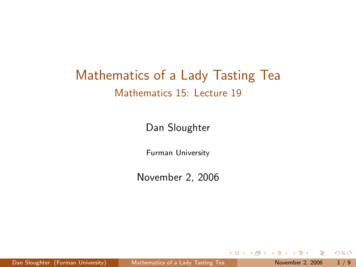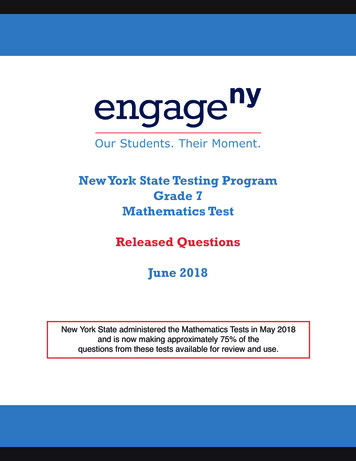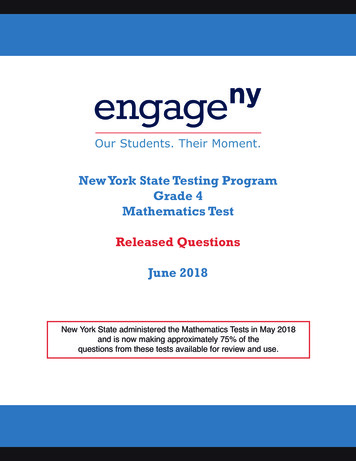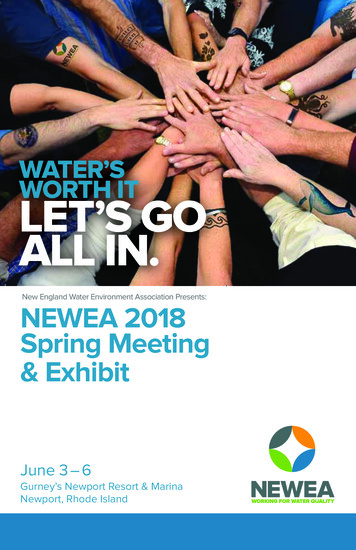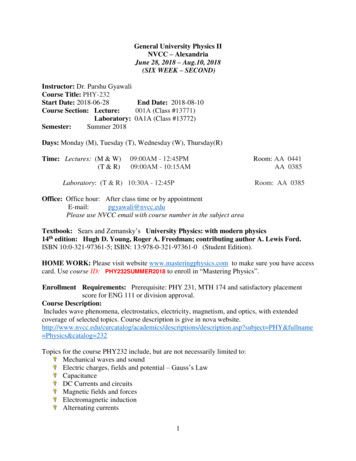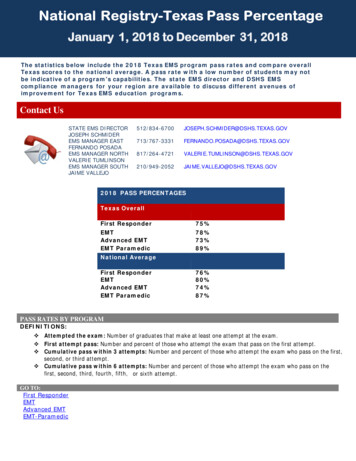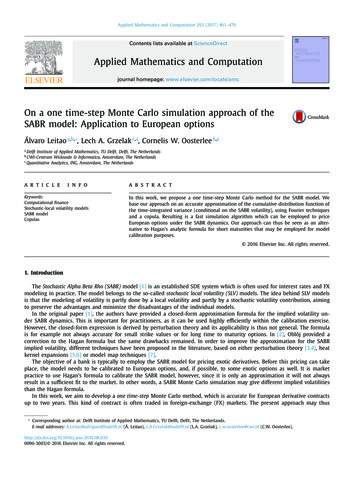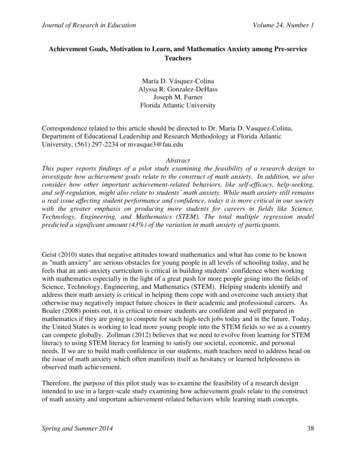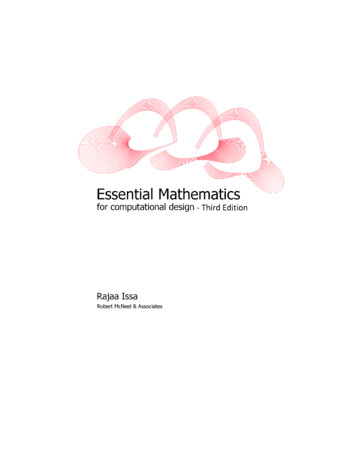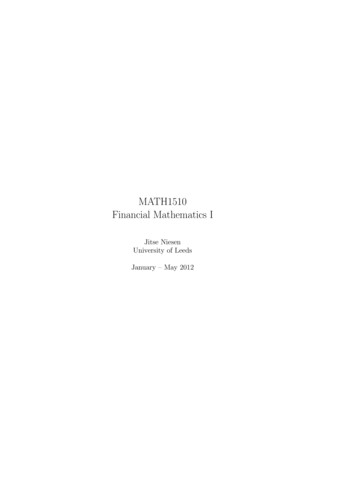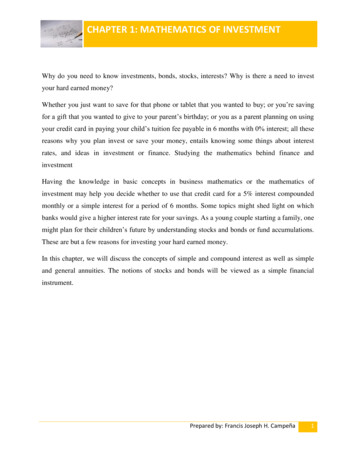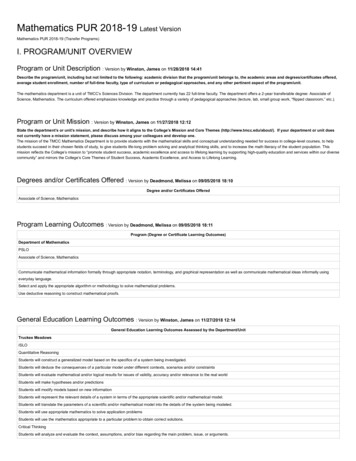
Transcription
Mathematics PUR 2018-19 Latest VersionMathematics PUR 2018-19 (Transfer Programs)I. PROGRAM/UNIT OVERVIEWProgram or Unit Description : Version by Winston, James on 11/28/2018 14:41Describe the program/unit, including but not limited to the following: academic division that the program/unit belongs to, the academic areas and degrees/certificates offered,average student enrollment, number of full-time faculty, type of curriculum or pedagogical approaches, and any other pertinent aspect of the program/unit.The mathematics department is a unit of TMCC’s Sciences Division. The department currently has 22 full-time faculty. The department offers a 2-year transferable degree: Associate ofScience, Mathematics. The curriculum offered emphasizes knowledge and practice through a variety of pedagogical approaches (lecture, lab, small group work, “flipped classroom,” etc.).Program or Unit Mission : Version by Winston, James on 11/27/2018 12:12State the department’s or unit’s mission, and describe how it aligns to the College’s Mission and Core Themes (http://www.tmcc.edu/about/). If your department or unit doesnot currently have a mission statement, please discuss among your colleagues and develop one.The mission of the TMCC Mathematics Department is to provide students with the mathematical skills and conceptual understanding needed for success in college-level courses, to helpstudents succeed in their chosen fields of study, to give students life-long problem solving and analytical thinking skills, and to increase the math literacy of the student population. Thismission reflects the College’s mission to “promote student success, academic excellence and access to lifelong learning by supporting high-quality education and services within our diversecommunity” and mirrors the College’s Core Themes of Student Success, Academic Excellence, and Access to Lifelong Learning.Degrees and/or Certificates Offered : Version by Deadmond, Melissa on 09/05/2018 18:10Degree and/or Certificates OfferedAssociate of Science, MathematicsProgram Learning Outcomes : Version by Deadmond, Melissa on 09/05/2018 18:11Program (Degree or Certificate Learning Outcomes)Department of MathematicsPSLOAssociate of Science, MathematicsCommunicate mathematical information formally through appropriate notation, terminology, and graphical representation as well as communicate mathematical ideas informally usingeveryday language.Select and apply the appropriate algorithm or methodology to solve mathematical problems.Use deductive reasoning to construct mathematical proofs.General Education Learning Outcomes : Version by Winston, James on 11/27/2018 12:14General Education Learning Outcomes Assessed by the Department/UnitTruckee MeadowsISLOQuantitative ReasoningStudents will construct a generalized model based on the specifics of a system being investigated.Students will deduce the consequences of a particular model under different contexts, scenarios and/or constraintsStudents will evaluate mathematical and/or logical results for issues of validity, accuracy and/or relevance to the real worldStudents will make hypotheses and/or predictionsStudents will modify models based on new informationStudents will represent the relevant details of a system in terms of the appropriate scientific and/or mathematical model.Students will translate the parameters of a scientific and/or mathematical model into the details of the system being modeled.Students will use appropriate mathematics to solve application problemsStudents will use the mathematics appropriate to a particular problem to obtain correct solutions.Critical ThinkingStudents will analyze and evaluate the context, assumptions, and/or bias regarding the main problem, issue, or arguments.
General Education Learning Outcomes Assessed by the Department/UnitStudents will discuss the implications and consequences of their own work, including conclusions, findings, projects, or products.Students will draw valid conclusionsStudents will evaluate the quality of supporting data or evidence.Students will identify and evaluate relevant and valid points of view, including cultural values, conceptual models, theoretical frameworks, or different methodologiesStudents will identify and summarize, or explain the main question(s), problem(s), issue(s), points and/or argument(s).Students will state a position, perspective, thesis, hypothesis, argument, or findings, based on a line of reasoning and/or evidence.Five-Year Plan Summary : Version by Lambert, Theodore on 12/07/2018 18:35What are the major objectives that the department/unit hopes to accomplish, including an estimated time to completion?Offering two new classes, MATH 295 and Math 330, so that the TMCC AS in Mathematics will transfer seamlessly towards a mathematics bachelors degree at UNR (completion asap).Better aligning curriculum and standards throughout all courses so that all students will acquire the skills necessary to succeed in the course and subsequent courses (ongoing objective).Offering each semester a schedule that best allows students to comply with the NSHE Gateway policy that requires degree seekers to finish a college level course within two semestersafter enrolling at TMCC (ongoing objective). Development of course guides for both math 95 and math 96. These will better enable us to standardize both curriculum and standards giventhe number of part-time faculty teaching these How does the department/unit plan to improve student learning?The department works to properly place students so that they will have the prerequisite skills upon beginning a class. The department continues to offer a variety of class formats aimed atserving the variety of student needs. The department works with the Tutoring Center to ensure that students are properly helped during tutoring sessions. The department encourages inhouse and external professional development for its faculty aimed at enhancing each faculty member's pedagogical approaches. The department is working to align its online classes withQM standards. The department encourages its faculty to work with the Disability Resource Center to ensure accessibily to its classes for students with disabilities. The departmentencourages the use of a variety of classroom technologies to enhance the teaching of math courses at all levels--technologies such as ActionPoint, Adobe Pro, ALEKS, graphingcalculators, CamScanner, Camtasia, Desmos, GeoGebra, Graph.exe, Homework Assistant, IMPERIO software, Kaltura, Mathematica, and many more.How does the department/unit plan to improve degree and/or certificate completions or course completions?MATH 295 and Math 330 will allow TMCC AS in Mathematics students a seamless 2 2 transition into a mathematics bachelors degree at UNR. Timely degree/certificate completion restsupon timely course completion: a current major and ongoing focus of the department is to offer each semester a schedule that best allows students to comply with the NSHE Gateway policythat requires degree seekers to finish a college level course within two semesters after enrolling at TMCC.How does this departmental/unit level plan align to the College’s mission (http://www.tmcc.edu/about/) and Strategic Master an2014.pdf#search "strategic master plan" )? Specifically, to whichcore theme(s), objective(s), and indicator(s) does (do) the departmental/unit level plan align?The mission of the TMCC Mathematics Department--to provide students with the mathematical skills and conceptual understanding needed for success in college-level courses, to helpstudents succeed in their chosen fields of study, to give students life-long problem solving and analytical thinking skills, and to increase the math literacy of the student population--closelyreflects the College’s mission to promote student success, academic excellence and access to lifelong learning.What resources does the department/unit anticipate needing in order to complete the 5-year plan?Finding degree-qualified part time instructors remains a major obstacle: qualified part time math instructors will choose to teach at UNR rather than at TMCC because they are paid more atUNR than at TMCC. Paying degree-qualified TMCC math instructors at the same rate as UNR part-time instructors would help alleviate this problem. More high tech, TIER 2 classroomsare needed during high demand times.II. CURRENT STATUS OF THE PROGRAM/UNITSummary of Previous PUR Findings and Annual Progress Reports (APRs) : Version by Lambert, Theodore on 12/07/201818:40
Describe the major findings and recommendations for the program/unit from the last PUR and any APRs.1. The budget situation at TMCC is a significant factor affecting curriculum. Performance-based funding concepts will likely put tremendous pressure on the Department to increase studentpass rates, potentially at the expense of student success as it relates to outcomes and standards.2. The Department is committed to encouraging student use of available academic support services such as tutoring and supplemental instruction, but larger institutional investment willneed to be made in these services for increased student success and accessibility.3. Another significant factor affecting curriculum is the proliferation of Massive Open Online Classes, (MOOCs), which could allow under-prepared students to gain access to TMCCMathematics courses if MOOCs are accepted as equivalent to TMCC prerequisites. It is imperative that institutional and departmental policies be established which require students to showprerequisite skills in the absence of institutionally recognized articulation agreements.4. The general acceptance of the Complete College America recommendations will decrease the relevancy of the current set of course outcomes relative to the aims of therecommendations. What will likely result is a need to re-design course outcomes so foundational skills, (Developmental skills), can be woven into the college level outcomes whilemaintaining acceptable college-level Standards for Intellectual Development. A process for re-designing the course outcomes will need to be implemented to address the lack of prerequisiteskills. In order for this process to be completed successfully, additional Professional Development opportunities for Faculty will need to be made available5. There is a clear break in the data beginning in the fall 2009 semester. The percentage of students taking a developmental math class prior to completing 12 credits fell from 86% to 76%.This is due to TMCC restructuring its developmental offerings. Many fewer sections of math 095 and 096 were offered, and math 093 is no longer offered at TMCC. One effect of this is todelay enrollment in a developmental math class at TMCC. This is not necessarily negative, since it includes students taking classes who are in the Skills Center and who thus delayenrolling in a developmental class.6. Over the past 5 years, the Math Department has seen an increase in retention rates for developmental classes (41% Fall 07 to 64% Spring 12) as well as for college classes (58% Fall 07to 68% Spring 12). The department continually reviews the data and assesses each course on a continual basis in order to make adjustments to the curriculum, course requirements,Accuplacer cut scores and teaching methods that will help improve retention and student success. As we look towards the future, this assessment of the data must continue and isimperative to meeting the demands of the students while maintaining a high level of rigor in the courses offered in the department.7. The department will also look to increase the enrollment of female and Hispanic students in the STEM focused university parallel courses as these groups tend to be underrepresentedacross the nation. As mentioned in the demographic findings, we already see a higher percentage of these groups in developmental courses, but our target would be to increase the percentof these groups in STEM math courses with completion of the math emphasis.8. Cooperation and communication with local high school students is an important task of the college and the math department. As such, it is suggested that this work continues.9. In the coming years, the department plans on offering more mini sessions available for a greater variety of courses. Currently, we offer mini sessions for Math 95 and Math 96, but are inthe planning process to offer it for Math 120, Math 126, and Math 127. Additionally, this will help meet the needs of the students since they will potentially be able to complete the requiredmath classes in one semester. The department is also currently looking into offering stretch courses as well to help shorten the time it takes students to complete the math requirements.These stretch classes will incorporate developmental and college level math class material in within one semester. All of these new course offerings will need to be assessed in the comingyears to determine their effectiveness. Self-Study Summary10. As a large department, it is necessary to maintain communication with part-time faculty. Current work by math faculty is being done in conjunction with the college to create a bestpractices document for working with part-time faculty to improve communication with students and to ensure the curriculum is being covered and assessed. It is suggested that workcontinues on this document and is made available for all faculty to review and implement in the coming years.11. With a full-time/part-time ratio of roughly 60/40 we are doing well compared to the college average which is 53/47. With the difficulties associated with finding qualified part-time faculty inmathematics, we hope to keep the ratio at its present level or improve it further.Which findings and recommendations has the program/unit addressed?The math department is now offering a wide range of class options for students. These include mini-session, hybrid, online, lecture, jumpstart, summer bridge, large lecture, and stretch.We now allow students to enter math 120 with a B or better in math 95, thus allowing students to bypass math 96.In our previous PUR the dean recommended that we assess our courses less frequently to allow time to implement recommendations prior to the next assessment cycle. We have built acomprehensive and strategically designed assessment schedule through the year 2022.We have been unable to find and/or retain part-time faculty qualified to teach UP math classes (classes at the 100 level). UNR offers these same potential faculty more money for thesame classes so without differential pay we have been unable to recruit them.We are in the process of creating course guides for math 95 and math 96 to maintain consistent curriculum given the high percentage of part-time faculty teaching these courses.Which have yet to be accomplished? Which are no longer relevant, and why?Any of the previous recommendations which have not been accomplished will be ongoing for the math department for the foreseeable future.Describe any major changes that the program/unit has undergone since the last PUR.We are adding math 330 and math 295 to our course offerings.A new placement test is being implemented starting in 2019. This test was not selected by the math department nor was it our preferred placement product. We were involved in theselection of scores to be used and will need to monitor how well it works.External Review : Version by Lambert, Theodore on 12/03/2018 18:18If applicable, describe the major recommendations made by external reviewers, such as advisory boards, articulation committees, program accreditors, etc. What progresshad the department/unit made towards those recommendations?N/AIII. CURRICULUMTransfer Programs (AA/AS Degrees) : Version by Ellsworth, Julie on 07/31/2019 22:59Which Bachelor’s degrees(s) does the program’s AA or AS degree(s) align with, especially within the Nevada System of Higher Education (NSHE)?The Associate of Science, Mathematics is a two-year transferable degree. This program will provide students with the necessary background in calculus and differential equationsneeded for a bachelor’s degree in mathematics and will also provide the computer science needed for a bachelor of science degree at UNR. All courses recommended will partially satisfythe degree requirements for any of the bachelor’s degree options offered by the mathematics department at the University of Nevada, Reno.Does the program’s suggested course sequence allow for efficient completion of the AA or AS? Explain.
As can be seen from the recommended course sequence in the catalog, it is very possible for a student to complete a mathematics emphasis at TMCC in four semesters. This includes allgeneral education and other non-math courses required for the degree.Recommended Course Sequence1st semesterUnitsCS 135 (http://catalog.tmcc.edu/search/?P CS%20135)Computer Science I3ENG 101 (http://catalog.tmcc.edu/search/?P ENG%20101) Composition I3or ENG 113 (http://catalog.tmcc.edu/search/?P ENG%20113) or Composition I for International Students3Fine Arts3Science 33MATH 181 (http://catalog.tmcc.edu/search/?P MATH%20181)Calculus I4Semester Total162nd semesterCS 202 (http://catalog.tmcc.edu/search/?P CS%20202)Computer Science II3U.S. and Nevada Constitutions 33ENG 102 (http://catalog.tmcc.edu/search/?P ENG%20102) Composition II3or ENG 114 (http://catalog.tmcc.edu/search/?P ENG%20114) or Composition II For International StudentsScience 33MATH 182 (http://catalog.tmcc.edu/search/?P MATH%20182)Calculus II4Semester Total163rd semesterElective 43Humanities 33Science 36MATH 283 (http://catalog.tmcc.edu/search/?P MATH%20283)Calculus III4Semester Total164th semesterSelect 2 electives 46Social Science/Diversity 33MATH 285 (http://catalog.tmcc.edu/search/?P MATH%20285)Differential Equations3Semester Total12Total Units60Are there any hidden prerequisites (courses which have 1 or more pre-requisites that are not listed as part of the program)?The two course listed as prerequisites for the AS degree in mathematics are math 126 and math 127. It is expected that the overwhelming majority of mathematics degree seekingstudents will have completed these prior to enrolling at TMCC. However, for those students who have not completed the precalculus courses (since they are college level classes), TMCCoffers both classes in the mini-session format, which allows students to complete both math 126 and math 127 in one semester. In addition, students may take both math 126 and 127during our two-session summer programs.Since math 285 has math 182 as a prerequisite, it is possible for an under-prepared student still to complete the AS mathematics degree in four semesters. Math 126 and math 127 canboth count toward the degree as electives so that the requirement of 60 credit hours is not surreptitiously raised.Does the AA or AS transfer seamlessly in a 2 2 agreement without a loss of credits or a substantial amount of courses counting only as general electives? Explain.Currently, though the AS degree in mathematics is close to transferring seamlessly to the Mathematics baccalaureate program at the University of Nevada, Reno, the university has anon-standard course, MATH 295 – Proof Writing for Math/Stat Major, in their B.A. and B.S degree requirements.Faculty in the TMCC math department are presently in process of designing and preparing a course, MATH 295, equivalent to this required class as UNR. Upon approval of this classand publication in the TMCC catalog, and integration into the TMCC curriculum for the mathematics AS degree, the transfer to a mathematics bachelors degree at UNR will be a seamless 2 2 transfer.Is program and course information up-to-date in the catalog? Explain.The math department is constantly reviewing and updating all math course information for all
Offering two new classes, MATH 295 and Math 330, so that the TMCC AS in Mathematics will transfer seamlessly towards a mathematics bachelors degree at UNR (completion asap). Better aligning curriculum and standards throughout all courses so that all students will acquire the skills nece

